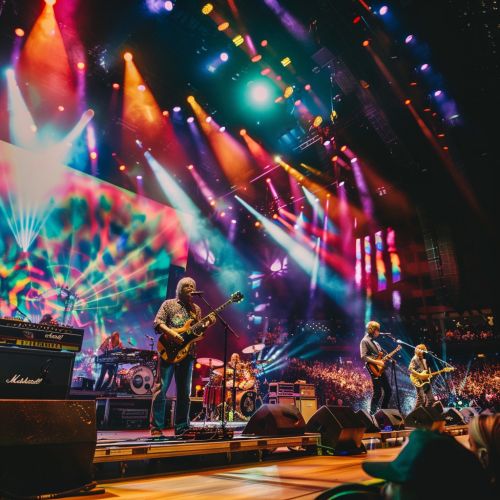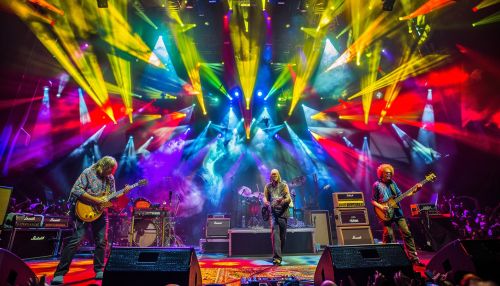The Grateful Dead
History
The Grateful Dead was an American rock band formed in 1965 in Palo Alto, California. The band was known for its eclectic style, which fused elements of rock, folk, country, jazz, bluegrass, blues, gospel, and psychedelic rock. The founding members were Jerry Garcia (lead guitar, vocals), Bob Weir (rhythm guitar, vocals), Ron "Pigpen" McKernan (keyboards, harmonica, vocals), Phil Lesh (bass, vocals), and Bill Kreutzmann (drums). The band is known for its unique and diverse live performances, long jams, and devoted fan base known as "Deadheads."
Formation and Early Years (1965-1967)
The Grateful Dead originated from the remnants of a jug band called Mother McCree's Uptown Jug Champions. Jerry Garcia, a skilled banjo player, and Bob Weir, a young guitarist, were pivotal in transitioning the group into an electric rock band. The inclusion of Ron McKernan, who brought a blues influence with his harmonica and keyboard skills, and Phil Lesh, a classically trained trumpeter turned bassist, solidified the band's early sound. Bill Kreutzmann's drumming added a rhythmic complexity that became a hallmark of their music.
The band's first major performance was at one of Ken Kesey's Acid Tests, a series of events that combined the use of LSD with multimedia performances. These events were crucial in shaping the band's improvisational style and psychedelic sound.
Breakthrough and Psychedelic Era (1967-1970)
The release of their debut album, "The Grateful Dead," in 1967 marked the beginning of their recording career. However, it was their live performances that garnered them a significant following. The band's second album, "Anthem of the Sun," released in 1968, was a blend of studio and live recordings, showcasing their experimental approach to music.
During this period, the band became a central figure in the San Francisco Sound, a musical movement characterized by its psychedelic influences. Their third album, "Aoxomoxoa," released in 1969, continued this trend with its complex studio techniques and experimental sounds.


Transition and Evolution (1970-1974)
The early 1970s were a period of transition for the Grateful Dead. The release of "Workingman's Dead" and "American Beauty" in 1970 marked a shift towards a more country and folk-influenced sound. These albums featured acoustic instruments and harmonies, drawing from traditional American music.
The band's live performances during this period were characterized by extended improvisational jams. The "Live/Dead" album, released in 1969, captured the essence of their live shows and became a seminal live album in rock history.
Hiatus and Return (1974-1979)
In 1974, the Grateful Dead took a hiatus from touring, citing the need for a break from the grueling schedule. During this period, the band members pursued solo projects and other musical endeavors. Jerry Garcia formed the Jerry Garcia Band, while Bob Weir formed Kingfish.
The band returned to touring in 1976, rejuvenated and with a renewed sense of purpose. The release of "Terrapin Station" in 1977 marked a return to their earlier experimental style, with complex compositions and orchestral arrangements.
Continued Success and Challenges (1980-1989)
The 1980s were a period of both success and challenges for the Grateful Dead. The band continued to tour extensively, building a loyal fan base that followed them from show to show. The release of "In the Dark" in 1987 brought commercial success, with the single "Touch of Grey" becoming a hit.
However, the band faced numerous challenges, including health issues among its members. Jerry Garcia's struggles with diabetes and substance abuse were well-documented, and the band had to navigate these difficulties while maintaining their rigorous touring schedule.
Final Years and Legacy (1990-1995)
The 1990s saw the Grateful Dead continue to tour and release music, but the health issues of Jerry Garcia became increasingly severe. Despite these challenges, the band remained a powerful live act, drawing large crowds and maintaining a dedicated fan base.
Jerry Garcia's death in 1995 marked the end of the Grateful Dead as a touring band. However, the band's legacy lived on through their extensive catalog of live recordings, studio albums, and the continued devotion of their fans.
Musical Style and Influences
The Grateful Dead's musical style was a fusion of various genres, including rock, folk, country, jazz, bluegrass, blues, and gospel. Their ability to blend these diverse influences into a cohesive sound was one of their defining characteristics.
Improvisation and Live Performances
One of the hallmarks of the Grateful Dead's music was their emphasis on improvisation. Their live performances often featured extended jams, with each member contributing to the spontaneous creation of music. This approach was influenced by jazz musicians like John Coltrane and Miles Davis, who were known for their improvisational skills.
The band's live shows were also characterized by their unpredictability. No two performances were the same, and the setlists varied from night to night. This approach fostered a sense of community among their fans, who followed the band from show to show to experience the unique performances.
Songwriting and Lyrics
The Grateful Dead's songwriting was a collaborative effort, with contributions from various members of the band. Jerry Garcia and Robert Hunter formed a prolific songwriting partnership, with Hunter providing the lyrics and Garcia composing the music. Their songs often featured poetic and enigmatic lyrics, drawing from a wide range of literary and cultural influences.
Bob Weir also contributed significantly to the band's repertoire, often collaborating with lyricist John Perry Barlow. Weir's songs brought a different perspective to the band's music, with a focus on storytelling and character-driven narratives.
Instrumentation and Sound
The Grateful Dead's instrumentation was diverse and eclectic. Jerry Garcia's lead guitar playing was a central element of their sound, characterized by its fluidity and expressiveness. Bob Weir's rhythm guitar provided a counterpoint to Garcia's lead, with complex chord voicings and syncopated rhythms.
Phil Lesh's bass playing was unconventional, often taking on a melodic role rather than simply providing a rhythmic foundation. Bill Kreutzmann and Mickey Hart's drumming added a polyrhythmic complexity to the band's music, drawing from a wide range of percussion traditions.
Cultural Impact and Legacy
The Grateful Dead's influence extended beyond their music, impacting various aspects of culture and society. Their innovative approach to live performances, fan engagement, and business practices set them apart from other bands of their era.
Deadheads and Fan Culture
The Grateful Dead's fan base, known as "Deadheads," played a crucial role in the band's success. Deadheads were known for their dedication, often traveling long distances to attend multiple shows. The sense of community among Deadheads was fostered by the band's inclusive and open approach to their fans.
The band encouraged fans to record their live performances, leading to a vast archive of live recordings. This practice was unusual at the time and contributed to the band's enduring legacy. The Grateful Dead's openness to fan recordings and their emphasis on live performances created a unique bond between the band and their audience.
Business Practices and Innovations
The Grateful Dead were pioneers in various aspects of the music business. They were one of the first bands to establish their own record label, Grateful Dead Records, giving them greater control over their music and business operations. The band also embraced new technologies, such as the internet, to connect with their fans and distribute their music.
Their innovative approach to ticketing, merchandising, and fan engagement set a precedent for future bands and artists. The Grateful Dead's business practices were characterized by a focus on community and collaboration, rather than traditional profit-driven models.
Influence on Other Artists
The Grateful Dead's influence can be seen in the work of numerous artists across various genres. Their emphasis on improvisation and live performances inspired many jam bands, such as Phish and Widespread Panic. The band's eclectic style and willingness to experiment with different genres also influenced a wide range of musicians, from rock to electronic music.
Discography
The Grateful Dead's discography includes a mix of studio albums, live recordings, and compilations. Their extensive catalog reflects their diverse musical influences and their emphasis on live performances.
Studio Albums
- The Grateful Dead (1967)
- Anthem of the Sun (1968)
- Aoxomoxoa (1969)
- Workingman's Dead (1970)
- American Beauty (1970)
- Wake of the Flood (1973)
- From the Mars Hotel (1974)
- Blues for Allah (1975)
- Terrapin Station (1977)
- Shakedown Street (1978)
- Go to Heaven (1980)
- In the Dark (1987)
- Built to Last (1989)
Live Albums
- Live/Dead (1969)
- Grateful Dead (Skull & Roses) (1971)
- Europe '72 (1972)
- History of the Grateful Dead, Volume One (Bear's Choice) (1973)
- Steal Your Face (1976)
- Reckoning (1981)
- Dead Set (1981)
- Without a Net (1990)
Members
The Grateful Dead's lineup evolved over the years, with various members joining and leaving the band. The core members, however, remained consistent throughout their career.
Core Members
- Jerry Garcia – lead guitar, vocals (1965–1995)
- Bob Weir – rhythm guitar, vocals (1965–1995)
- Phil Lesh – bass, vocals (1965–1995)
- Bill Kreutzmann – drums (1965–1995)
Other Members
- Ron "Pigpen" McKernan – keyboards, harmonica, vocals (1965–1972)
- Mickey Hart – drums (1967–1971, 1974–1995)
- Tom Constanten – keyboards (1968–1970)
- Keith Godchaux – keyboards (1971–1979)
- Donna Jean Godchaux – vocals (1972–1979)
- Brent Mydland – keyboards, vocals (1979–1990)
- Vince Welnick – keyboards, vocals (1990–1995)
- Bruce Hornsby – keyboards, vocals (1990–1992)
